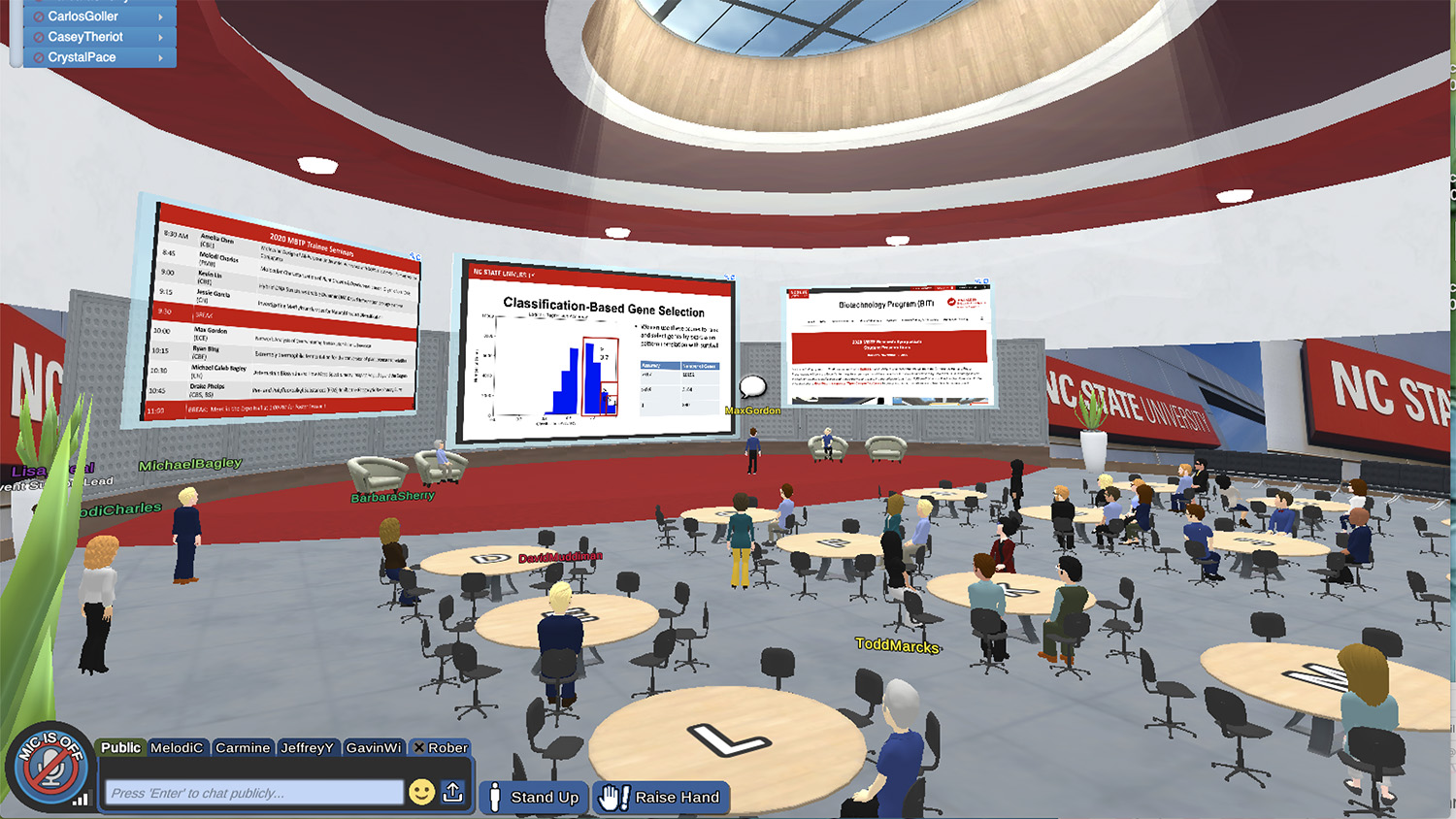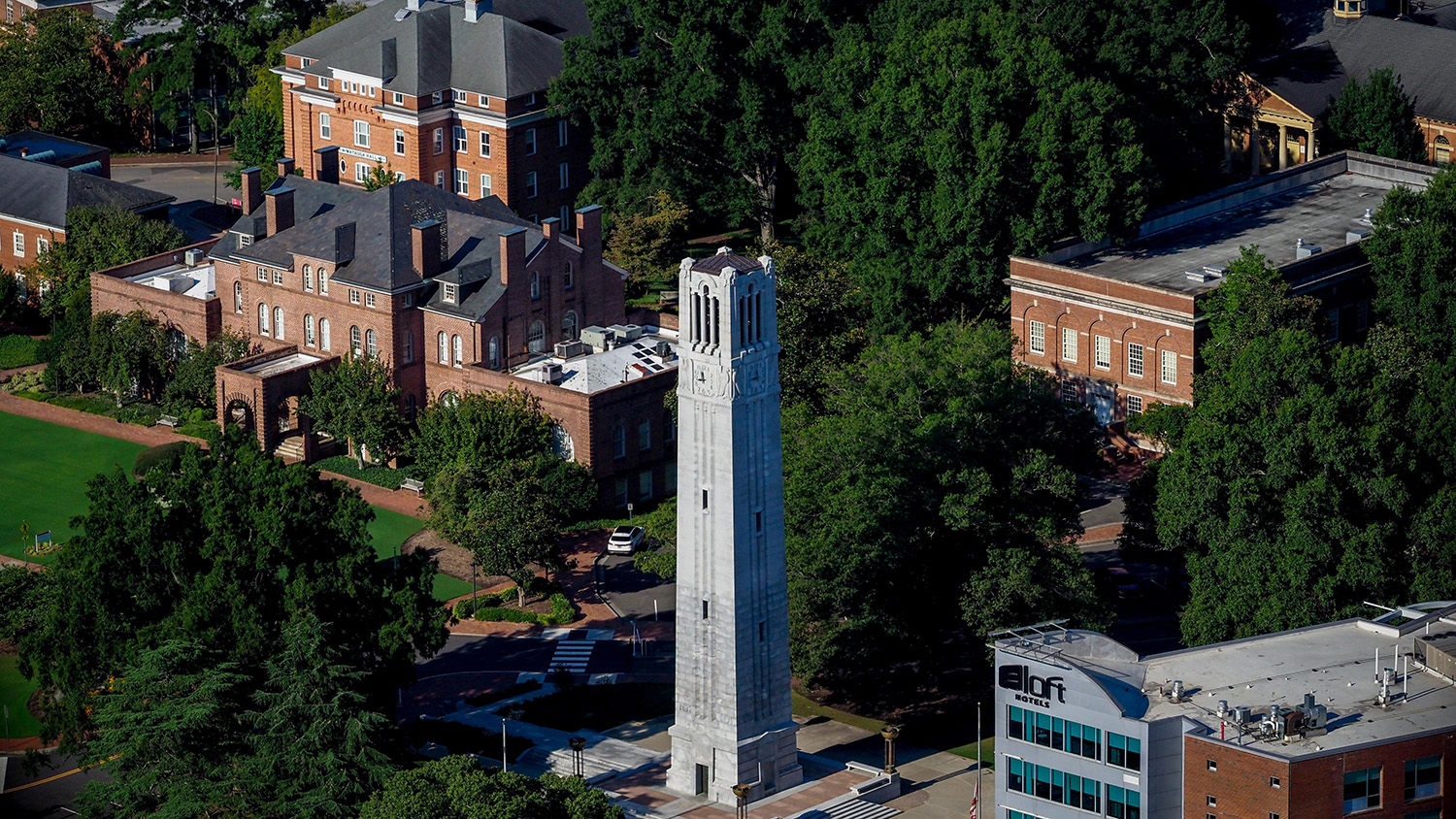Annual Symposium Goes Virtual

Online learning — now a hallmark of higher education during the COVID-19 pandemic — can take some quite innovative and delightful forms. This includes the recent graduate student virtual symposium for NC State’s Molecular Biotechnology Training Program (MBTP).
Generally, the annual event, supported by the NC Biotechnology Center and hosted by the NC State Biotechnology Program, takes place at the McKimmon Conference and Training Center, but 2020 necessitated a change in plans. Conference organizers wanted something different from the online meetings that have become all too familiar for faculty, staff and students alike.
A New Format
A key feature in presenting an engaging event was finding a format in which multiple conversations could happen at the same time in one room, with a flow of conversation that could closely mimic real time. VirBELA, the chosen platform, provided unique software and a fun atmosphere that helped uplift the morale of participants.
“We had our own virtual campus, with a variety of buildings to explore and to use for our event,” said Laura Schenkman, Biotechnology Program coordinator. “In advance of the symposium, we decorated billboards and screens around the virtual campus with scientific art, NC State logos and images to make it more like ‘home.’”
Because of travel restrictions this year, three keynote speakers addressed audiences via Zoom on the topic of “Vaccines Development and Deployment.” Jeffrey Yoder, a professor of innate immunology in the College of Veterinary Medicine, hosted the session by guiding the discussions and collecting audience questions for the speakers.
Graduate Students Adapt
The day of the symposium, 26 graduate students gave oral presentations in a conference hall and presented posters on their research in the virtual expo center. These student presenters created avatars and interacted with symposium attendees entirely virtually.
Julia Grzymkowski, a third-year toxicology Ph.D. student, presented her research at the symposium as part of her MBTP Fellowship. She studies the effects of the herbicide atrazine on the development of the intestine. Atrazine has been associated with structural birth defects in human epidemiology studies, and she is researching the possible cellular and molecular mechanisms behind this association. Her most recent data has shed some light on that mechanism, which may involve modulation of cellular metabolism by atrazine.
“I presented a poster of my most recent data to the group, and enjoyed the keynote speakers from the symposium and learning more about the process of vaccine development and how that is changing because of COVID. I think it was a very timely topic to discuss this year,” she said. “I also love seeing all the different types of research coming out of the program and am proud to be a part of such a diverse group.”
Other graduate student participants gave positive feedback on the uniqueness of the event and the ease of communicating with others in a nontraditional type of symposium.
“The virtual environment allowed me to get a bit creative and allowed me to share other things (media, websites, news articles, etc.) to give my audience a richer experience,” said Kyle Tomek, a Ph.D. student in chemical engineering. “It was also a nice ice breaker during conversations since it was such a new experience for everyone — it made it easy to approach others I may not have talked to in person.”
During the event, symposium planners coordinated technical support and engaged in poster judging. Each student presenting a poster was visited by three of 24 faculty judges who provided feedback to organizers, and from their scoring, the top three posters were selected for award prizes.
The top three presenters were:
- Julia Grzymkowski (PI – Nanette Nascone-Yoder) – Developmental Exposure to the Ubiquitous Herbicide Atrazine Causes Defects in Intestinal Morphogenesis
- Ravi Appalabhotla (PI – Jason Haugh) – Directed Migration of Fibroblasts in Multi-cue Chemotactic and Haptotactic Gradients
- Melodi Charles (PI – Heike Sederoff) – Molecular Characterization of Plant Growth and Development Under Organic Solar Cells
What’s Next
Looking toward the future, symposium organizers note that having guest speakers in an online format may help them attract more high-profile speakers, as there is less of a burden on their time if they do not have to travel. Invitations could also be expanded to researchers further away, even outside the United States.
Though an in-person poster session is an important opportunity for students to develop key communication skills to explain their work to other researchers both in their own area of study and in other scientific or engineering fields, the virtual format provides that opportunity for students who may not be able to travel to larger conferences. Additionally, because feedback on the event was quite positive, a virtual format may be used for a workshop or other type of group presentations.
“The event seemed like a huge success and might well indicate the future of conferences,” said Gavin Williams, associate head of the Department of Chemistry and a conference organizer. “Overall, the event was an opportunity for students and faculty to share their science and to network with each other in an unusual way. It was a pleasant distraction from the usual format and really encapsulated the Think and Do spirit at NC State.”
- Categories:


